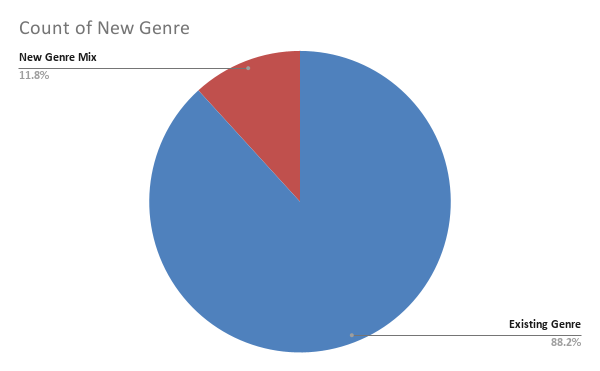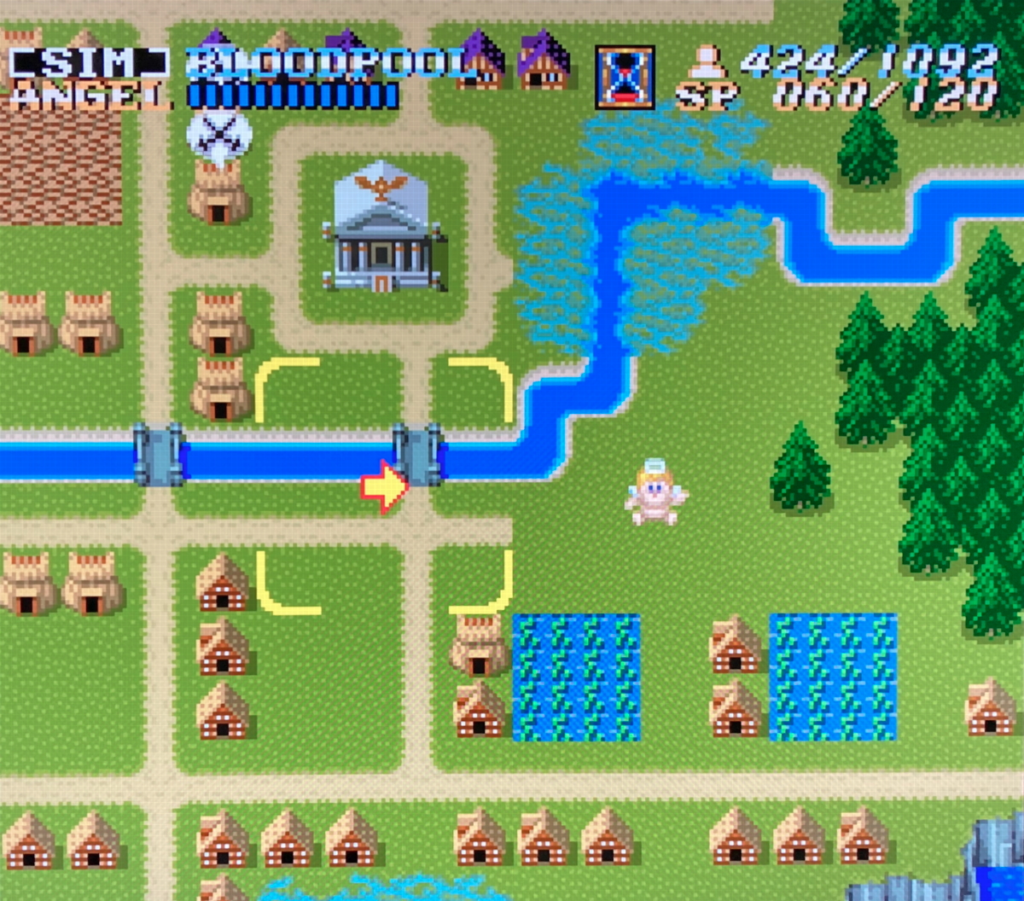
Your game’s genre and graphic style is the biggest determinant of your game’s potential success. Marketing decisions such as whether you use twitter or tiktok don’t matter as much as the type of game you make.
Game development has thousands of these tiny risky pitfalls that don’t seem like a big problem but actually carry a huge risk. For instance, making a 2D puzzle platformer is incredibly risky but it doesn’t seem like that if you just look at screenshots.
In today’s blog I want to cover another risk that doesn’t seem that big: Mixing Genres. Popular indie games such as Crypt of the Necrodancer (Rhythm + Dungeon Crawler) and Portal (FPS + Puzzle) make it seem as if genre mixing is our birthright as indies.
However, I think it is actually much riskier to mix genres than we have thought. The safer choice (and it might be sacrilege for me to say this) is to make slight tweaks to a popular genre instead of doing these big bold genre mixes.
The data behind this big risk
In January, I looked at all the indie games from 2022 that earned over 1000 reviews (there were 416 of them) and then I went through and looked at the genres and how they were described in the short description and the tags. I counted all the games that considered themselves as a cross between two or more genres.
Second, I only counted novel genre mixes. For instance a decade ago Spelunky became a hit because it was the first to successfully mix the two genres of top-down-roguelikes and side-scrolling-platformers. Now 2D platformers are basically a genre unto themselves. In fact there are mixes within mixes. There are 2D roguelikes + metroidvanias. It is so common that Steam added the tag “Roguevania.” Basically, if Steam has a tag for it, it isn’t a novel genre mix.
Although Rogue Legacy 2 was a hit that released in 2022, I do not consider it a novel genre mix. It is now just a slight tweak on an existing genre.
2022 was also very exciting because we saw the birth of a new genre with Vampire Survivors. That is a successful, novel genre mix! But all those fast-follow vampire-survivor-likes that quickly sprouted, I did not count them as a novel genre mix. Here are those games:
- Brotato
- 20 Minutes Till Dawn
- Soulstone Survivors
- Rogue: Genesia
- Necrosmith
- Seraph’s Last Stand
- Tiny Rogues
- Boneraiser Minions
- Nomad Survival
- Bounty of One
- Spirit Hunters: Infinite Horde
I argue that these VS-likes are actually slight variations on a proven genre-mix.
More about the hit games
Sorry, quick commercial break. I did a whole lecture looking back at 2022’s hit games. You can watch it if you subscribe to my premium site GameMarketingIdeas.com and save 50%.
The 11% of hit games that were genre mixes
So, here are the games that I consider novel genre mixes. All of these games were successful and found an audience and I would argue are a novel mix of 2 or more genres.
- Vampire Survivors
- Teardown
- Cult of the Lamb
- Dorfromantik
- Potion Craft: Alchemist Simulator
- Dwarf Fortress
- Stacklands
- Hardspace: Shipbreaker
- FPS Chess
- Neon White
- Not For Broadcast
- Metal: Hellsinger
- The one who pulls out the sword will be crowned king
- DAVE THE DIVER
- Peglin
- Dome Keeper
- Knightfall: A Daring Journey
- Gordian Quest
- Songs of Conquest
- 依盖之书 book of yog
- Rogue Tower
- Baldi’s Basics Classic Remastered
- Hero’s Hour
- Shotgun King: The Final Checkmate
- Bugsnax
- We Who Are About To Die
- Backpack Hero
- Potion Permit
- Kynseed
- How Fish Is Made
- Boneraiser Minions
- Card Shark
- Blade Assault
- Outpath: First Journey
- Souldiers
- Ship of Fools
- Space Beast Terror Fright
- Idle Skilling
- Save Room – Organization Puzzle
- Waifu Fighter
- I Was a Teenage Exocolonist
- LEGIONCRAFT
- FurryFury
- Idle Calibur
- Last Command
- Crystal Clash
- Rollerdrome
- Cultivation Story: Reincarnation
That seems like a lot but, the vast majority of games that did well in 2022, were slight variations or improvements on existing genres.

So why are there so few true, novel, successful, genre mixes? And why am I recommending the safer bet is just try to make a straight-up-the-middle genre game? Here are 3 reasons
#1 Mixes are very hard for first time devs
Designing even the most simple game in a well established genre is like walking a tightrope. Adding any mechanic, or buffing or nerfing one value can leave your game unbalanced or frustrating, knocking you off the “rope” and crashing down to earth.
Now consider an indie who has never released any game but they are dead set on mixing genres for their first game. It is like saying
”I have NEVER walked across a tightrope before, but I am going to try it while also juggling flaming knives and singing an Italian opera (a language I don’t speak)”
A first time indie
And then even if you could do it, would anyone want to watch that?
It is obvious that this one person circus act is a ridiculous endeavor, so why do thousands of indies working on their first game decide to create a horror-themed-rhythm-card-battler-city-builder?
#2 You are more likely to alienate players
Most of the steam shopping public is not that adventurous. They have very strict genre preferences. They know what they like and what they don’t like. When mixing genres you run a real risk of blending two incompatible tastes. Instead of appealing to audience A and audience B you actually alienate them and are left with a very very small group of people that happen to like both.
Chicken shawarma is good
Ice cream is good
But chicken shawarma flavored ice cream?
#3 Mixed genres mean longer development times
It depends on how your design is cross breading the genres, but there is a chance you are actually stacking the genres instead of mixing them.
Consider the classic game Actraiser where you must build a settlement using classic top down city building mechanics and then expel demons in a classic side scrolling action platformer. If your mix is actually a stack of genres, you are essentially developing two games simultaneously!
Actraiser is a combination city builder

AND a 2D action platformer

Again, it is hard enough to make and balance and debug one game. Mixing two games isn’t just twice as hard, it can be exponentially more difficult because every single mechanic of each genre must align and work together in a fun and interesting way for this chimera to work.
So how do we stand out if mixes are risky?
AKA: What’s the point of being indie anymore?
I can see the tweets I am going to get already:
“There goes old man Zukowski again telling indies not to be so weird and creative.”
That Twitter Guy
I know I know. One of the first bits of advice indies get is “have a hook.” That is true! But if your hook is too weird, it can alienate the typical gamer. In fact, I think most indies get a bit too crazy with their hook.
Let’s go back to my list of 2022 hit games and the 88.2% of games that are NOT novel genre mixes?
What is their hook?
To make it simple, let’s look at all the hit survival craft games and their hook:
- Raft (survival game but at sea)
- V Rising (survival game but you a vampire)
- Stranded Deep (survival game but on an island )
- The Planet Crafter (survival game but on another planet)
- Stranded: Alien Dawn (survival game but on another another planet)
I also wrote about horror games. Most of those aren’t genre twists, they are just variations of different monsters chasing you.
Basic “hooks” or changes that I saw in most of these top earning games
You can have a hook that isn’t just Game A + Game B! Fans are attracted to much less. Here are some popular “hooks” I saw from 2022 and the game that benefited from it:
- Taking a game that is typically 3D and making it 2D – ZERO Sievert
- Taking a game that is typically 2D and making it 3D – Soulstone Survivors is a 3D variation of Vampire Survivors.
- Making a game that is typically in space, and making it set in Medieval times – Clanfolk which is a colony sim popularized by Rimworld.
- Make a single player game multiplayer – Inside the Backrooms
- Making a dark game bright (Haiku the Robot is a bright colorful Metroidvania)
- Changing the job to be done (all the simulation games are basically changes in who you are simulating)
If anything, the success of Vampire-Survivor-likes have shown us how slight changes to a proven genre can yield success.
So there are so many ways to improve upon a game that falls somewhere between a “clone” and a total genre mixup. Here are some ideas of how you can make a variation of a hit game:
- Make the graphics better
- Make the graphics simpler or clearer
- Patch fundamental design flaws
- Fix the late-game
- Fix the onboarding early game
- Make the game more accessible to a more casual audience (but be careful about too casual)
- Make the game more hardcore
- Make a wholesome game grimdark
- Make a grimdark game wholesome
- Add multiplayer
- Make a multiplayer-only game singleplayer
- Make something that is typically hand-made and make it procedurally generated
- Make something that is a limited resource and make it an infinite resource
Most advanced yet acceptable
This is where I once again post this great article about Raymond Loewy and his principle of MAYA (Most Advanced yet Acceptable).

Basically most people only want a 20%-30% improvement on a product.
When you do a genre mix you are essentially changing 50% or more of the product! Sometimes it works, but usually not. The public thinks the change is too much and don’t buy.
I’m not your dad
So what? Do whatever you want, that is the whole thing about going indie. I just want you to price in the risks before you mortgage your house to hire another programmer.
But how will we grow?
So if every indie game developer listened to Chris, and only made tiny genre variations, how will we ever grow as an industry? Where will fresh ideas come from?
I will be covering this topic in next week’s blog post but my TL;DR argument is to scale the risk of the genre mix to your game dev experience and to the scale and budget of the project.
Here is a hastily drawn MSPaint drawing showing this: